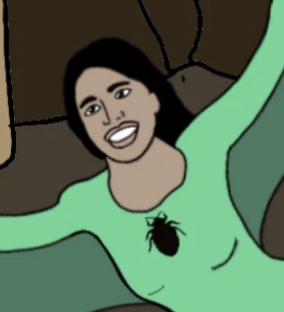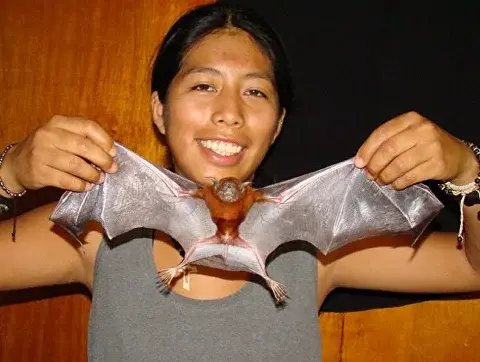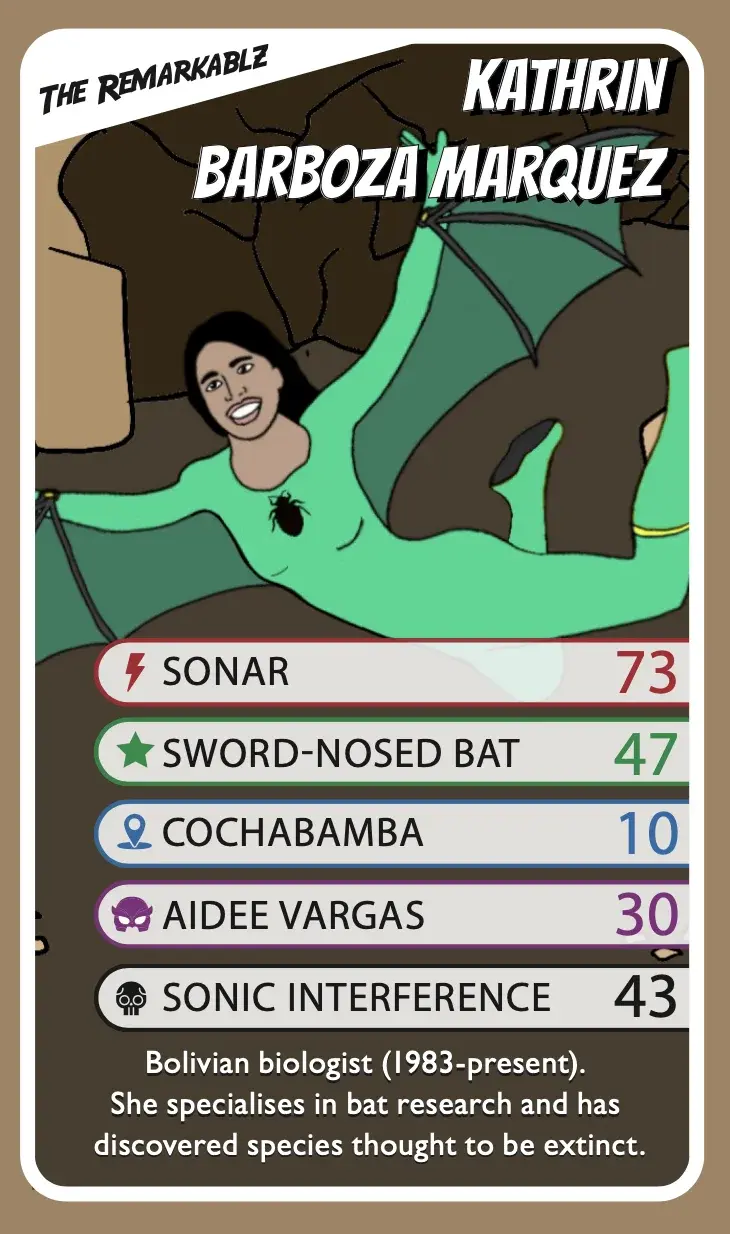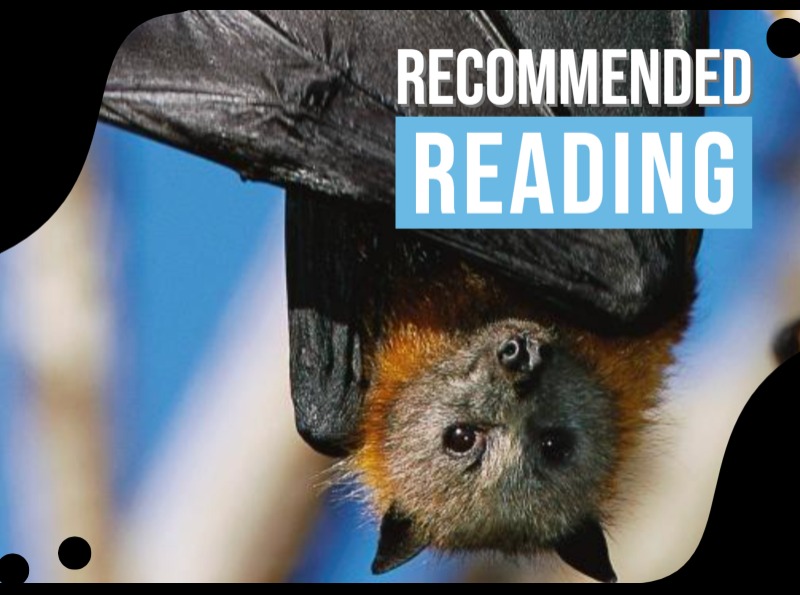
Get to Know
Kathrin Barboza Marquez
Discover why we turned this science hero into a superhero
WHO IS KATHRIN BARBOZA MARQUEZ?
Name: Kathrin Barboza Marquez
Born: 1983
Occupation: Biologist
Nationality: Bolivian
Kathrin is a biologist and one of the leading experts in bat conservation in South America. Her passion for bats began during her time at the Universidad Mayor de San Simón, where she dedicated her thesis to studying the reproductive patterns of fruit bats.
Early in her career, Kathrin made headlines when she rediscovered the Nariz de Espada (sword-nosed bat), a species long thought to be extinct in Bolivia. Kathrin later developed one of Bolivia’s first echolocation libraries—cataloguing the unique ultrasonic calls of insect-eating bats. This work has become a valuable tool for researchers and conservationists working to protect these animals.
Born: 1983
Occupation: Biologist
Nationality: Bolivian
Kathrin is a biologist and one of the leading experts in bat conservation in South America. Her passion for bats began during her time at the Universidad Mayor de San Simón, where she dedicated her thesis to studying the reproductive patterns of fruit bats.
Early in her career, Kathrin made headlines when she rediscovered the Nariz de Espada (sword-nosed bat), a species long thought to be extinct in Bolivia. Kathrin later developed one of Bolivia’s first echolocation libraries—cataloguing the unique ultrasonic calls of insect-eating bats. This work has become a valuable tool for researchers and conservationists working to protect these animals.

In The Remarkablz Universe... As a child Kathrin loved exploring caves and listening to the echoes bounce off stone walls. One night, while deep inside a bat cave, she was caught in a sudden landslide. Trapped in darkness, with no light and no way to escape, Kathrin instinctively let out a silent yell —and heard it return to her. In that moment, something changed. Kathrin discovered she could see with sound. The echoes formed images in her mind—crystal-clear outlines of tunnels, roots, rocks, and even the heartbeats of tiny cave creatures. Guided by this newfound power, she navigated the cave and emerged safely the next morning.
Kathrin can map entire ecosystems using only sound, detect invisible threats, and guide lost explorers to safety. With every mission, she fights to protect endangered species and preserve the balance between humans and the animal world. As a key member of Team Remarkablz, Kathrin is known as The Echo Mapper.
Kathrin can map entire ecosystems using only sound, detect invisible threats, and guide lost explorers to safety. With every mission, she fights to protect endangered species and preserve the balance between humans and the animal world. As a key member of Team Remarkablz, Kathrin is known as The Echo Mapper.
Superhero Backstory
Kathrin features in our signature card game, Top Quarkz. The game supports the development of maths, literacy and decision-making skills all while learning about some of the most impressive scientific discoveries throughout history. He also features in our colouring poster, Fetters Chaos.
We've explained the drawing and her playing card below so you can learn more.
We've explained the drawing and her playing card below so you can learn more.
Kathrin can map the world around her by using sound.
The drawing of a bug on her superhero outfit is an ectoparasite. These parasites, like fleas, live on the outside of their hosts. Kathrin conducted a study of ectoparasites on the bat population of the Savanna.
Superpower
Kathrin tracked down the sword-nosed bat. The species was believed to be extinct.
Kathrin was born, and grew up in Cochabamba, Bolivia.
Location
SideKick
Kathrin worked with her mentor Aideé Vargas to track down the sword-nosed bat.
Sonic Interference interferes with Kathrin's ability to release sound waves (sonar).
Weakness
Each drawing we create has one or more hidden treasure(s) about our superheroes' life experiences, depictions in art, jobs or discoveries. Did you find the ones hidden in this drawing?
Discovery

We have packed a lot into our Top Quarkz playing cards - from amazing imagined superpowers to biographical information and hidden treasures.
EDUCATIONAL RESOURCES
What's a biologist?
Biologists study humans, animals, plants and bacteria to gain a better understanding of how the body and nature works, and how external factors may influence each organism. There are many sub-branches of biology you could choose to explore.
Biologists can work in macroscopic (objects that are measurable and visible to the naked eye) or microscopic (requires microscopes to view the objects) biology.
Video credit: SciShow Kids
Biologists can work in macroscopic (objects that are measurable and visible to the naked eye) or microscopic (requires microscopes to view the objects) biology.
Video credit: SciShow Kids
Bats Aren't as Scary as You Think
Take a look at how many common bat misconceptions came about and just how vital bats are to our everyday lives.
Video credit: National Geographic
Video credit: National Geographic
How does echolocation work?
Watch this video to find out how bats "see" the world around them as they look for prey in the dark.
Video credit: SciToons
Video credit: SciToons
Cool facts about bats
Find out cool facts about bats—from how and where they live, to what they eat and how they talk to each other.
- Most bats have only one pup (baby) a year, making them extremely vulnerable to extinction.
- The world's largest bat is called the "flying fox" (Pteropus bats). It has a wingspan of up to 6 feet.
- Bats make up a quarter of all mammals. There are more than 1,100 species of bats in the world!
DIY Echolocation Experiment for Kids: Discover How Bats "See" with Sound
Step 1: Set up your science station
Place your materials on a flat surface like a table or desk.
Step 2: Position the paper towel tubes
Angle the tubes toward each other (but don’t let them touch). Secure them to the table with tape so they stay in place.
Step 3: Add the echolocation “target”
Place the aluminum pie plate on its edge, about 12 inches in front of the tubes. Tape it down.
Step 4: Whisper through the tube
Have one person softly whisper into one of the tubes.
Step 5: Listen closely
The other person should put their ear to the second tube. Can they hear the whisper bounce back? That sound is an echo!
Place your materials on a flat surface like a table or desk.
Step 2: Position the paper towel tubes
Angle the tubes toward each other (but don’t let them touch). Secure them to the table with tape so they stay in place.
Step 3: Add the echolocation “target”
Place the aluminum pie plate on its edge, about 12 inches in front of the tubes. Tape it down.
Step 4: Whisper through the tube
Have one person softly whisper into one of the tubes.
Step 5: Listen closely
The other person should put their ear to the second tube. Can they hear the whisper bounce back? That sound is an echo!
What you will need
- 2 empty paper towel tubes
- 2 aluminum pie plates
- Tape
- 1 ruler or measuring tape
- 2 people
What's Happening?

Looking for a hands-on science activity to teach kids about echolocation? This simple, at-home experiment uses everyday materials to demonstrate how bats use sound waves to "see" their surroundings. Perfect for primary school science lessons, homeschoolers, or curious minds!
Step-by-Step Instructions
When a sound is made, it travels until it hits an object (like the pie plate), then bounces back as an echo. The animal’s brain uses the returning sound to figure out:
This is how many nocturnal animals “see” in the dark—with sound instead of sight!
- How far away the object is
- Its shape and size
- Whether it’s moving or still
This is how many nocturnal animals “see” in the dark—with sound instead of sight!
"Listening to them is an indescribable emotion, it is about making something that nobody can hear audible." Kathrin Barboza Marquez
Want to discover more? Dive into the world of our science superheroes
Kathrin features in our card game: Top Quarkz
Discover our free educational resources and activities
Bats: Level 3 - by Elizabeth Carney
Don't miss out, sign up to our Newsletter!
DISCOVER MORE

A Remarkablz Product
Sign up to our Newsletter
By signing up to receive emails, you agree that we may use the personal information provided by you to send you marketing emails. You can opt out of these emails any time by clicking the unsubscribe link or by contacting us. To see how we use your personal data, please see our Privacy policy.



